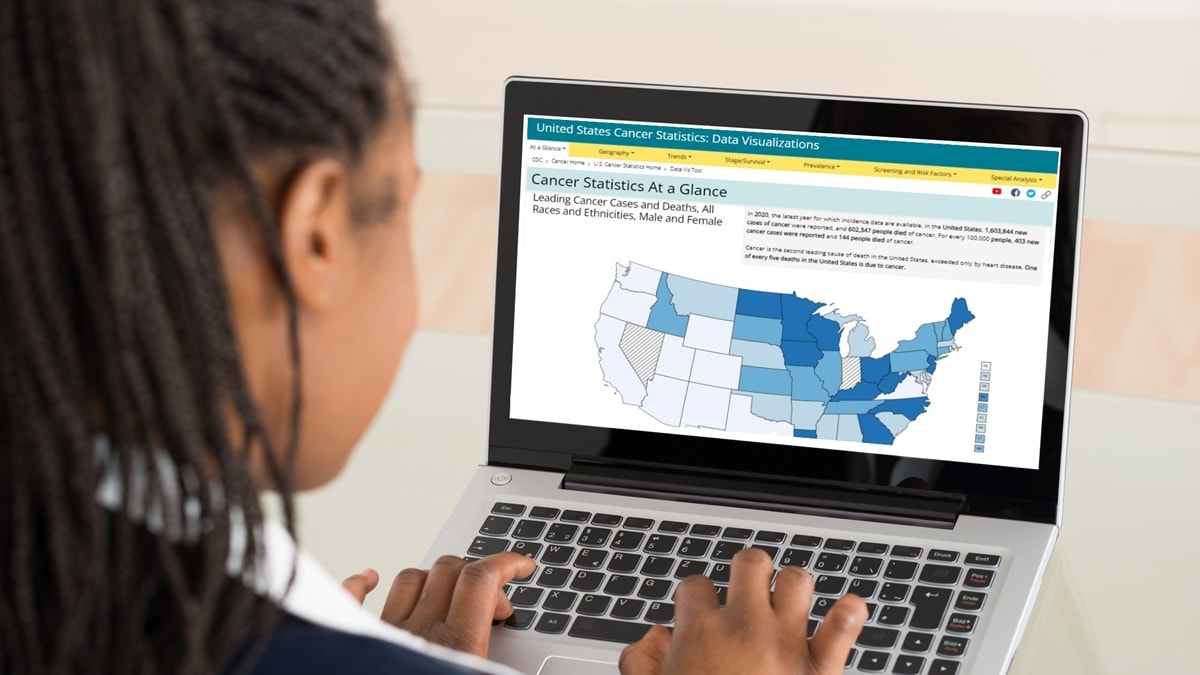What to know
The U.S. Cancer Statistics Data Visualizations tool shows the official federal cancer statistics from central cancer registries that meet data quality criteria.

Overview
The U.S. Cancer Statistics Data Visualizations tool displays the official federal statistics on cancer from each central cancer registry meeting data quality criteria. The Centers for Disease Control and Prevention's (CDC's) National Program of Cancer Registries (NPCR) and the National Cancer Institute's (NCI's) Surveillance, Epidemiology, and End Results (SEER) Program combine their cancer incidence data sources to produce these statistics. Mortality data are from CDC's National Center for Health Statistics (NCHS) National Vital Statistics System (NVSS).
What data does the U.S. Cancer Statistics Data Visualizations tool contain?
The U.S. Cancer Statistics Data Visualizations tool displays the official federal cancer statistics. This tool provides incidence and death counts, rates, stage distribution, and trend data; survival and prevalence estimates; and state-, county-, and congressional district-level data in a user-driven format. It includes incidence data on more than 1.8 million cases of invasive cancer diagnosed each year. The population coverage may vary due to suppression (for example, if 16 or fewer cases were reported or if the state requested suppression), or if a state did not meet U.S. Cancer Statistics publication criteria. For the most recent release, data from 100% of the U.S. population are displayed for cancer cases diagnosed in 2022 alone and the most recent 5 years combined (2018 to 2022).
The tool also includes malignant cancer mortality data from all 50 states, the District of Columbia, and Puerto Rico as recorded in the NVSS. Mortality data are available for 100% of the U.S. population for cancer deaths reported in 2023 alone and 5 years combined (2019 to 2023).
Incidence and mortality data are available for the nation, state, congressional district, and county. Cancer incidence and mortality trend data are presented from 1999 through 2022 and 1999 through 2023, respectively. The most recent year for which incidence data are available is 2022 and cancer mortality data are available for 2023.
The tool also presents national and state survival and prevalence estimates, which are based on NPCR data covering 87.3% of the U.S. population. The tool also includes information about the prevalence of risk factors related to cancer, use of cancer screening tests, and status of human papillomavirus (HPV) immunization.
How can the data be used?
These data can be used to monitor cancer trends over time, determine cancer patterns in various populations, guide planning and evaluation of cancer control programs, help set priorities for allocating health resources, and provide information for a national database of cancer incidence.
What was the effect of COVID-19 on cancer incidence data?
See Effects of COVID-19 on cancer incidence data.
What cautions should be used in interpreting rates by race and ethnicity?
See Interpreting Race and Ethnicity in Cancer Data.
What cautions can be used in interpreting rates by congressional districts?
The cancer incidence and death counts and rates presented for congressional districts are estimated using county-level data because direct measures on congressional district-level data are not available. Please be mindful that these are estimated counts and rates, and they are not meant to be compared across congressional districts. For more information, see Incidence and Death Estimates by Congressional District.
Whom can I contact for questions about the U.S. Cancer Statistics Data Visualizations tool?
Please email U.S. Cancer Statistics staff at uscsdata@cdc.gov.
Suggested citation
U.S. Cancer Statistics Data Visualizations Tool. U.S. Department of Health and Human Services, Centers for Disease Control and Prevention and National Cancer Institute; www.cdc.gov/cancer/dataviz, released in June 2025.
Resources
References
1Thompson CA, Gomez SL, Hastings KG, et al. The burden of cancer in Asian Americans: a report of national mortality trends by Asian ethnicity. Cancer Epidemiol Biomarkers Prev. 2016;25(10):1371–1382.
2Heron, MP. Comparability of race-specific mortality data based on 1977 versus 1997 reporting standards. Natl Vital Stat Rep. 2021;70(3):1–31.
3Liu L, Noone AM, Gomez SL, et al. Cancer incidence trends among native Hawaiians and other Pacific Islanders in the U.S., 1990–2008. J Natl Cancer Inst. 2013;105(15):1086–1095.
4Gomez SL, Noone AM, Lichtensztajn DY, et al. Cancer incidence trends among Asian American populations in the United States, 1990–2008. J Natl Cancer Inst. 2013;105:1096–1110.
5Centers for Disease Control and Prevention. Highlights from 2022 U.S. Cancer Statistics. Centers for Disease Control and Prevention, U.S. Department of Health and Human Services; 2025.
